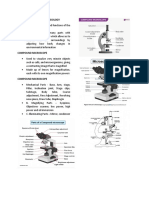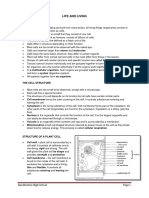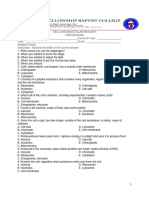Cell Biology and Micros
Cell Biology and Micros
Uploaded by
mariamCopyright:
Available Formats
Cell Biology and Micros
Cell Biology and Micros
Uploaded by
mariamOriginal Description:
Original Title
Copyright
Available Formats
Share this document
Did you find this document useful?
Is this content inappropriate?
Copyright:
Available Formats
Cell Biology and Micros
Cell Biology and Micros
Uploaded by
mariamCopyright:
Available Formats
it is believed that every single living organism we see on earth , when dismantled is made of cells.
cells are the smallest unit of life. cells
have membranes. these membranes are important these control substances that enter or leave the cell. The role that they play in ensuring
cells transport or communicate with each other.
microscopy, cells are put under a microscope
when we strip every living thing into its smallest unit we will see a cell. what many people dont know is that cells are very microscopic. you
cant just look into the environment and see a cell, you need to put it under a microscope.
1. light microscope- see some organelles but cant see much as e.m
2. electron microscope- complicated, have to have training, uses electron beam. can see a lot more
light microscope
how does the light microscope work.
the eye piece (ocular) focuses the image from the object lenses(zooming in
or out of an image of the specimen) 10x, 40x, 100x magni cation. eye
pieces are 10x the magni cation. so that means when you observe a
specimen you use 10 x objective lens, the magni cation is
10x10=100. the stage is where you put the slide, you specimen is in the
centre. at the bottom is a condenser, condenser helps light from the light
source. the light travel upward and illuminates, picked up by the objective
lens, size of the image picked up is dependent on the objective lens and
goes up to the eye piece. condense lens focus the light into the specimen.
iris of the condenser is used to control the light you get into your
specimen
basic di erences:
• animal cell is a round or spherical shaped cell that
contians alot of organelles. it has a nucleus, nucleolus.
ot has a smaller vaculoe, not often seen under l.m.
• plant cell also has nucleus and also nucleolus but then
it aslso has this biig wide organelle, called the vacuole;
it can be seen uner the microscope most of the time. it
has a large vaculoe usually for storage of waste material
or storage of water/ nutrient.plant cell has a lage central
vacuole.
what do plants and animals have in common?
smooth endoplasmic reticulu
the both have cell membranes. cells regulate what comes in and leaves the rough endoplasmic reticulu
cell.it plays an impt funtion. it also communicates with other cell. They aslo cell surface membrane/ plasma membran
contain nucleus and have cytoplasm (all of the di organelles are oating). Golgi apparatu
they have mitochondria (provide energy) it is the power house of the cell. cytoplas
mitochondria makes atp. they have golgi apparatus, important in nucleus (nuclear pores, nucleolus, nuclear envelope
mitochondrion
peroxisom
vacuole
transportation and folding protein made by the cell
You might also like
- S.1 Bio Notes PDFDocument57 pagesS.1 Bio Notes PDFkitderoger_391648570100% (6)
- Cell Structure and Function - Magnification CalculationDocument17 pagesCell Structure and Function - Magnification CalculationHamza KhanNo ratings yet
- The Microscope Parts and Use: Name: - PeriodDocument8 pagesThe Microscope Parts and Use: Name: - PeriodHector ZavalaNo ratings yet
- O Level Biology NotesDocument547 pagesO Level Biology NotesSsonko Edrine100% (1)
- Bio For Olevel PDFDocument422 pagesBio For Olevel PDFNalweyiso JoyceNo ratings yet
- Cells Basic Units of LifeDocument9 pagesCells Basic Units of LifeNadiyah KarriemNo ratings yet
- Biology-Notes-2020 031656 010915Document436 pagesBiology-Notes-2020 031656 010915amindhairya81No ratings yet
- BioLab ReviewerDocument6 pagesBioLab ReviewerM. Corales, Adrian Neil B.No ratings yet
- Unit 3 Cell BiologyDocument7 pagesUnit 3 Cell BiologyQaran PrintingNo ratings yet
- 1.1 Cell Structure and FunctionDocument7 pages1.1 Cell Structure and Functionkingsleymakuvaza167No ratings yet
- Biology Notes O-LevelDocument432 pagesBiology Notes O-LevelJohn MatovuNo ratings yet
- Science Year 7 Biology Autumn 1 Cells Year 7 2Document2 pagesScience Year 7 Biology Autumn 1 Cells Year 7 2pagiga4775100% (1)
- Cell Biology: Science Explorer - Cells and HeredityDocument242 pagesCell Biology: Science Explorer - Cells and HeredityZeinab ElkholyNo ratings yet
- Lap BioDocument66 pagesLap Bioroaaouran93No ratings yet
- INTRODUCTION TO BIOLOGY ........Document10 pagesINTRODUCTION TO BIOLOGY ........gumisirizabriankarungiNo ratings yet
- Bio Module 12Document45 pagesBio Module 12afeefaNo ratings yet
- Microscope UseDocument7 pagesMicroscope Usebeg100% (1)
- B1.1 Knowledge OrganiserDocument3 pagesB1.1 Knowledge OrganisermtauhidNo ratings yet
- SCIENCE-7-POINTERSDocument4 pagesSCIENCE-7-POINTERSalasascsfpNo ratings yet
- Midterm Review (2) (1)Document10 pagesMidterm Review (2) (1)jielih1234No ratings yet
- Cells NatDocument62 pagesCells NatErinNo ratings yet
- Science Chapter 1Document13 pagesScience Chapter 1Asia BibiNo ratings yet
- CellsDocument86 pagesCellsspamiplviewNo ratings yet
- The Fundamental Unti of Life Cell Part 01Document4 pagesThe Fundamental Unti of Life Cell Part 01jeetjyoti787No ratings yet
- Introduction To MicroscopeDocument10 pagesIntroduction To MicroscopectfabilahNo ratings yet
- Genzoo Lab ReviewerDocument12 pagesGenzoo Lab ReviewerJohanna Daffny MadayagNo ratings yet
- Science ReviewerDocument5 pagesScience Reviewerrinnxuxi12No ratings yet
- General Biology 11 2Document7 pagesGeneral Biology 11 2kristinecarmel.duhaylungsodNo ratings yet
- Cell Structure and FunctionDocument4 pagesCell Structure and FunctionMichael100% (1)
- Biotech q1 ReviewerDocument7 pagesBiotech q1 Reviewerjeanettegongora7No ratings yet
- A. Unit y Diversity 2. CellsDocument66 pagesA. Unit y Diversity 2. CellshzunigaNo ratings yet
- Cell ShapingsmDocument7 pagesCell Shapingsmsqmxg123No ratings yet
- Anaphy Lab ReviewerDocument5 pagesAnaphy Lab ReviewerRhod Jayson RicaldeNo ratings yet
- Anaphy Lab Oral Recitation 1-7Document10 pagesAnaphy Lab Oral Recitation 1-7Niña C.No ratings yet
- Scicent QRN U4 Final eDocument11 pagesScicent QRN U4 Final e[2J08] Li Hoi Fung OwenNo ratings yet
- Unit C-Chapter 8 PowerpointDocument66 pagesUnit C-Chapter 8 Powerpointm_frajman100% (1)
- Grade 8 Rationalized Integrated Science Lesson Notes Term 2Document17 pagesGrade 8 Rationalized Integrated Science Lesson Notes Term 2josephnandiaNo ratings yet
- St. Teresita's Academy of Aritao, IncDocument2 pagesSt. Teresita's Academy of Aritao, IncMauro UbungenNo ratings yet
- Bio F1 The CellDocument52 pagesBio F1 The CellOfficial MikeyNo ratings yet
- Biology Midterms ReviewerDocument11 pagesBiology Midterms ReviewerMarianne ManglicmotNo ratings yet
- Ecz Grade 10 - 12 Biology Summarised Notes Pt.1 (Living Organisms)Document27 pagesEcz Grade 10 - 12 Biology Summarised Notes Pt.1 (Living Organisms)Leon Marko100% (1)
- Cells NoteDocument6 pagesCells NoteYolanda JesslinaNo ratings yet
- Gen Bio Long Quiz ReviewerDocument5 pagesGen Bio Long Quiz ReviewermarisNo ratings yet
- Genbio ReviewerDocument7 pagesGenbio ReviewerMary Jean BoNo ratings yet
- M 25 - The CELL - Introduction and Cell Types.Document67 pagesM 25 - The CELL - Introduction and Cell Types.brenda.mboghoNo ratings yet
- Advance Biology NotesDocument15 pagesAdvance Biology Notesvince luigi tamundongNo ratings yet
- Basic Microscopy: Are There Aliens Among Us?Document11 pagesBasic Microscopy: Are There Aliens Among Us?cormacNo ratings yet
- B1.1 Knowledge OrganiserDocument3 pagesB1.1 Knowledge OrganisermtauhidNo ratings yet
- The CellDocument4 pagesThe CellOlerato NtsimaneNo ratings yet
- Biology ReviewerDocument5 pagesBiology ReviewerGenesis CaimolNo ratings yet
- Activate 1Document184 pagesActivate 1Oya Ozkan YilmazNo ratings yet
- Eye Anatomy - Review 6Document7 pagesEye Anatomy - Review 6Vidini Kusuma AjiNo ratings yet
- Chapter 2 CellDocument43 pagesChapter 2 CellZaida TahirNo ratings yet
- Unit 2: Cells & MicroscopeDocument31 pagesUnit 2: Cells & MicroscopeSaisha SinghNo ratings yet
- Cell Structure and Function NotesDocument8 pagesCell Structure and Function NotesShiloh FrederickNo ratings yet
- Cell As A Unit of Life: Prepared by Ms Sue SohDocument8 pagesCell As A Unit of Life: Prepared by Ms Sue SohAliza Abu BakarNo ratings yet
- Cell As A Unit of LifeDocument10 pagesCell As A Unit of LifeanasyemmyNo ratings yet
- MODULE 2 The MicroscopeDocument14 pagesMODULE 2 The MicroscopeRaqz TVNo ratings yet
- Cell StructureDocument25 pagesCell Structurekaramfatma26No ratings yet
- A Simple Guide to the Eye and Its Disorders, Diagnosis, Treatment and Related ConditionsFrom EverandA Simple Guide to the Eye and Its Disorders, Diagnosis, Treatment and Related ConditionsNo ratings yet
- Xii Iit GTM - 5 Q.paper (25.12.23)Document19 pagesXii Iit GTM - 5 Q.paper (25.12.23)sudharsan1218ffNo ratings yet
- Ray Optics Practice SheetDocument14 pagesRay Optics Practice SheetyashietasethiNo ratings yet
- Optical Solutions For The AUG Assault RifleDocument2 pagesOptical Solutions For The AUG Assault Rifleakms1982No ratings yet
- Science Process Skills - MicroscopeDocument2 pagesScience Process Skills - MicroscopeCharina May Lagunde-SabadoNo ratings yet
- Clinical Parasitology LaboratoryDocument4 pagesClinical Parasitology LaboratoryLyka ReyesNo ratings yet
- Lab ReportDocument5 pagesLab ReportFatima Shiera BarraquiasNo ratings yet
- Quick - Vision New GenerationDocument40 pagesQuick - Vision New Generationdave judayaNo ratings yet
- Forensics Chapter 7Document17 pagesForensics Chapter 7Martin ClydeNo ratings yet
- Transes-Micropara Lab PrelimsDocument4 pagesTranses-Micropara Lab Prelimsmikhyla.cardenoNo ratings yet
- Stereoscopic Zoom Microscope SMZ645/ SMZ660: InstructionsDocument29 pagesStereoscopic Zoom Microscope SMZ645/ SMZ660: InstructionsRoBy RObNo ratings yet
- Physiology 1 Practical Notebook Submitted To: Dr. Aniza Ishaque Submitted By: Momina Nadeem Rimsha Zareen Abdullah Najam Aman SarfrazDocument18 pagesPhysiology 1 Practical Notebook Submitted To: Dr. Aniza Ishaque Submitted By: Momina Nadeem Rimsha Zareen Abdullah Najam Aman SarfrazMaryam ShahzadiNo ratings yet
- Optical Waveguide Polishing MachineDocument8 pagesOptical Waveguide Polishing MachineNitin BurmanNo ratings yet
- Microscopes by AmoebaDocument3 pagesMicroscopes by AmoebaNailah DalidigNo ratings yet
- DLL Week 1 G7 Science 22-23 Q2Document22 pagesDLL Week 1 G7 Science 22-23 Q2Lady MayugaNo ratings yet
- Content: Standard Operating Procedure (SOP) Maintenance of A Light MicroscopeDocument8 pagesContent: Standard Operating Procedure (SOP) Maintenance of A Light MicroscopechyeebiyooNo ratings yet
- Integrated Science Grade 7 NotesDocument75 pagesIntegrated Science Grade 7 Noteswww.simokumuNo ratings yet
- Botany Laboratory Activity No. 2Document6 pagesBotany Laboratory Activity No. 2nieb gayleNo ratings yet
- Evolution of Magnifications in Endodontics A RevieDocument5 pagesEvolution of Magnifications in Endodontics A RevieAnjali SatsangiNo ratings yet
- G11-2 Biology Microscope LabDocument3 pagesG11-2 Biology Microscope LabCharlene Cheng 程亮瑜No ratings yet
- Untitled Document-11Document11 pagesUntitled Document-11mananguetemrNo ratings yet
- Spesifikasi Teknis Nikon Eclipse Ci-L Plus BrightfieldDocument1 pageSpesifikasi Teknis Nikon Eclipse Ci-L Plus Brightfieldhanif mahendra100% (1)
- US2579903 - Periscopic Sextant - Kollsman, 1951Document9 pagesUS2579903 - Periscopic Sextant - Kollsman, 1951devheadbot100% (1)
- Lx400 ManualDocument27 pagesLx400 ManualDiana MirandaNo ratings yet
- Label The Microscope - Science Learning HubDocument1 pageLabel The Microscope - Science Learning Hubhuong024817No ratings yet
- NSTSE Class 10 Solutions 2015 PDFDocument8 pagesNSTSE Class 10 Solutions 2015 PDFmadhavNo ratings yet
- Sas Session 1Document6 pagesSas Session 1Bráian Tzéims άλμπαNo ratings yet
- Primo Tech User ManualDocument63 pagesPrimo Tech User ManualLuiggi FloresNo ratings yet
- Final Cell and Molecular Biology Prelim September 22 2021Document8 pagesFinal Cell and Molecular Biology Prelim September 22 2021shelahomero3No ratings yet
- Jack Meyers - Microscope - Make - Up - Lab - Webuest - 1Document3 pagesJack Meyers - Microscope - Make - Up - Lab - Webuest - 1meyersj27No ratings yet
- Activity Sheet: Part A Jigsaw PuzzleDocument2 pagesActivity Sheet: Part A Jigsaw PuzzleHazel Butal SampayanNo ratings yet

























































































